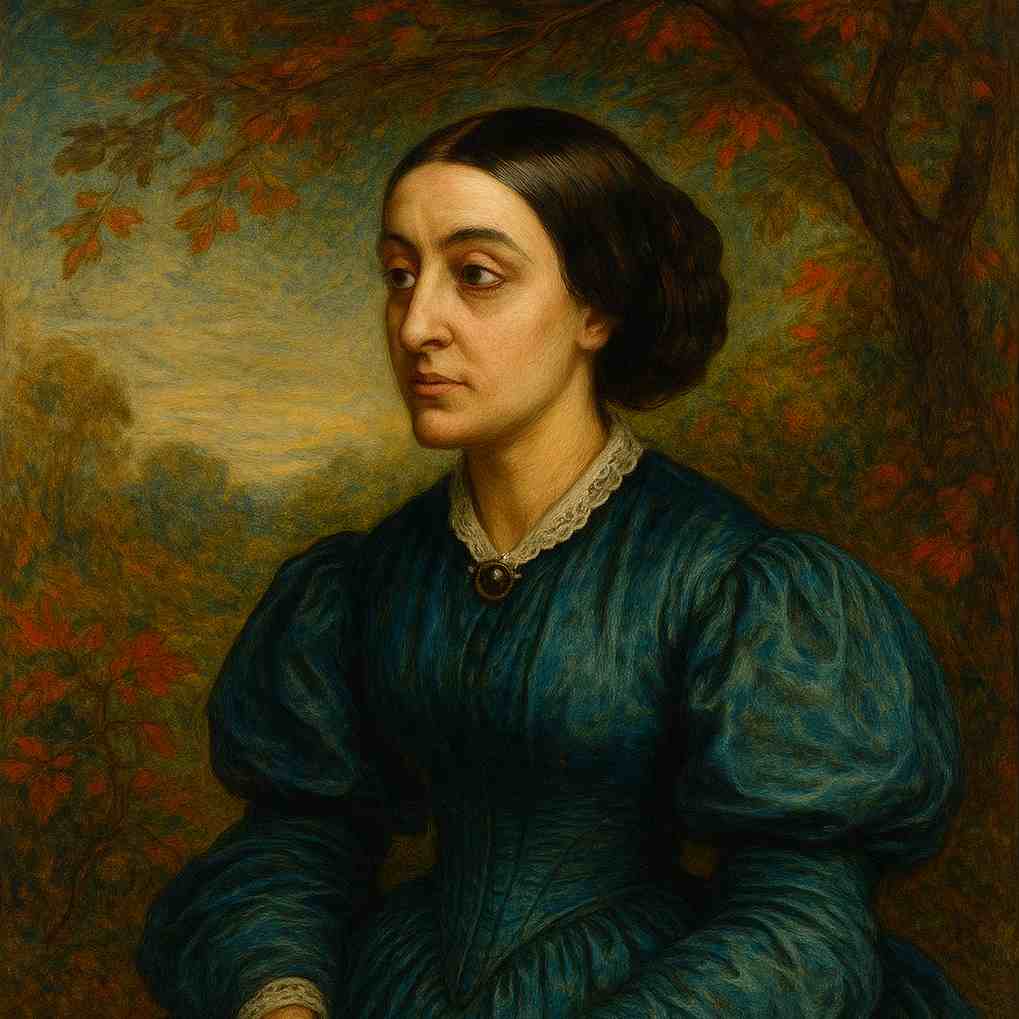A Dirge
Christina Rossetti
1830 to 1894

Want to track your favorites? Reopen or create a unique username. No personal details are required!
Why were you born when the snow was falling?
You should have come to the cuckoo’s calling,
Or when grapes are green in the cluster,
Or, at least, when lithe swallows muster
For their far off flying
From summer dying.
Why did you die when the lambs were cropping?
You should have died at the apples’ dropping,
When the grasshopper comes to trouble,
And the wheat-fields are sodden stubble,
And all winds go sighing
For sweet things dying.
Christina Rossetti's A Dirge
Christina Rossetti's poem "A Dirge," also known by its first line "Why were you born when the snow was falling?", is a poignant exploration of the seeming incongruity between the cycles of human life and the natural world. Through its structure, imagery, and thematic content, the poem invites readers to contemplate the relationship between human existence and the rhythms of nature, while also grappling with the fundamental questions of life, death, and the human condition.
Structure and Form
The poem consists of two stanzas, each containing six lines. This symmetrical structure reflects the balanced nature of the poem's central conceit: the first stanza addresses birth, while the second addresses death. The regularity of the form contrasts with the poem's thematic exploration of disharmony, creating a tension that underscores the work's emotional impact.
The rhyme scheme (ABCCDB) in each stanza contributes to the poem's musicality and reinforces its thematic unity. The repetition of the 'B' rhyme at the end of each stanza ("calling"/"falling" and "dropping"/"cropping") creates a sense of circularity, echoing the cyclical nature of the seasons that feature prominently in the poem's imagery.
Imagery and Symbolism
Rossetti's use of natural imagery is central to the poem's exploration of life, death, and temporality. The poem is rich with seasonal symbols that carry traditional associations:
- Snow (winter): traditionally associated with death, dormancy, and endings
- Cuckoo (spring): a harbinger of spring, symbolizing renewal and rebirth
- Green grapes (summer): representing growth, vitality, and the prime of life
- Apples dropping (autumn): suggestive of harvest, maturity, and the natural conclusion of life's cycle
These images are not merely decorative but serve to anchor the poem's philosophical inquiries in the tangible, observable world. The progression of seasons mirrors the progression of human life, from birth to death, creating a parallel between natural cycles and human existence.
Thematic Analysis
At its core, "A Dirge" is an elegiac meditation on the apparent mismatch between human life events and the natural order. The poem's central conceit—that there are more fitting times for birth and death—serves as a lens through which to examine broader existential questions.
The Incongruity of Human and Natural Cycles
The poem's repeated use of "Why" at the beginning of each stanza underscores a sense of bewilderment or protest against the timing of birth and death. This questioning stance implies a desire for harmony between human life events and natural cycles—a harmony that, the poem suggests, is often lacking.
The speaker posits that birth should coincide with spring or summer, seasons of growth and abundance. Similarly, death is suggested to be more fitting in autumn, a time of natural decline. This alignment would create a poetic symmetry between human life and natural cycles. However, the reality presented in the poem—birth in winter and death in spring—disrupts this idealized harmony.
The Persistence of Nature
A striking aspect of the poem is the way it portrays nature as indifferent to human events. The lambs continue "cropping" and the apples keep "dropping" regardless of human birth or death. This indifference highlights the smallness of individual human lives in the face of nature's enduring cycles.
Yet, paradoxically, by noting this indifference, the poem also underscores the profound human desire to find meaning and pattern in natural phenomena. The very act of questioning "Why" reveals a deeply human impulse to seek order and significance in the seemingly random events of life and death.
The Duality of Existence
Rossetti's poem subtly explores the dual nature of existence through its juxtaposition of life and death, beginning and ending. The birth in winter (traditionally associated with death) and the death in spring (typically linked with rebirth) create a complex interplay of opposites. This intertwining of life and death reflects a nuanced understanding of existence, where beginnings and endings are not clearly delineated but rather intermingled and interdependent.
Literary and Historical Context
"A Dirge" can be situated within the broader context of Victorian poetry and the Pre-Raphaelite movement, of which Christina Rossetti was a part. The poem's focus on nature and its symbolic potential aligns with Pre-Raphaelite ideals, while its exploration of mortality and the human condition resonates with broader Victorian preoccupations.
The poem's engagement with questions of cosmic order and human meaning can be seen as part of a larger cultural response to the scientific advancements of the 19th century, particularly Darwin's theory of evolution. As traditional religious explanations for the order of the world were challenged, poets like Rossetti sought new ways to understand humanity's place in the natural world.
Linguistic and Stylistic Features
Rossetti's linguistic choices contribute significantly to the poem's impact. The use of direct address ("You should have come," "You should have died") creates an intimate tone, as if the speaker is directly confronting the subject of the dirge. This directness lends an emotional intensity to the philosophical questions being posed.
The poem's diction is largely simple and accessible, drawing primarily on common natural imagery. However, Rossetti employs subtle alliteration ("summer sighing," "sweet things") and assonance ("wheat-fields are sodden stubble") to create a musicality that enhances the poem's emotive power.
The repetition of phrases ("You should have") and structures across the two stanzas creates a sense of inevitability, reinforcing the poem's exploration of natural cycles and fated events.
Conclusion
"A Dirge" is a masterful exploration of the human condition, using the apparent mismatch between individual human lives and natural cycles as a starting point for deeper philosophical and emotional inquiries. Through its careful structure, evocative imagery, and probing questions, the poem invites readers to contemplate their own place within the natural world and the broader sweep of existence.
Rossetti's work continues to resonate with modern readers, speaking to enduring human concerns about mortality, meaning, and our relationship with the natural world. In an age of increasing environmental awareness and existential questioning, "A Dirge" offers a poignant reminder of our complex and often paradoxical relationship with nature and the passage of time.
The poem's power lies not in providing answers but in articulating questions that lie at the heart of human experience. In doing so, it exemplifies poetry's capacity to grapple with the most profound aspects of existence, offering not resolution but a deepened appreciation for the complexity and mystery of life itself.
This text was generated by AI and is for reference only. Learn more
Want to join the discussion? Reopen or create a unique username to comment. No personal details required!



Comments
No comments yet. Be the first to comment!